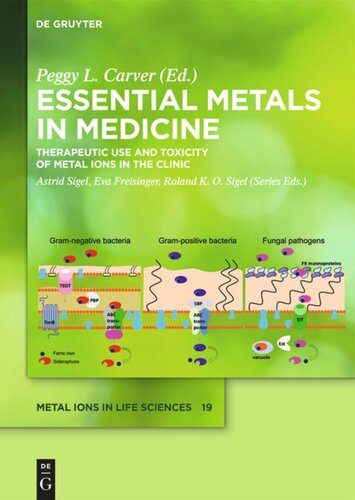

Most ebook files are in PDF format, so you can easily read them using various software such as Foxit Reader or directly on the Google Chrome browser.
Some ebook files are released by publishers in other formats such as .awz, .mobi, .epub, .fb2, etc. You may need to install specific software to read these formats on mobile/PC, such as Calibre.
Please read the tutorial at this link: https://ebookbell.com/faq
We offer FREE conversion to the popular formats you request; however, this may take some time. Therefore, right after payment, please email us, and we will try to provide the service as quickly as possible.
For some exceptional file formats or broken links (if any), please refrain from opening any disputes. Instead, email us first, and we will try to assist within a maximum of 6 hours.
EbookBell Team

4.4
42 reviewsVolume 19, entitled Essential Metals in Medicine: Therapeutic Use and Toxicity of Metal Ions in the Clinic of the series Metal Ions in Life Sciences centers on the role of metal ions in clinical medicine. Metal ions are tightly regulated in human health: while essential to life, they can be toxic as well. Following an introductory chapter briefly discussing several important metal-related drugs and diseases and a chapter about drug development, the focus is fi rst on iron: its essentiality for pathogens and humans as well as its toxicity. Chelation therapy is addressed in the context of thalassemia, its relationship to neurodegenerative diseases and also the risks connected with iron administration are pointed out. A subject of intense debate is the essentiality of chromium and vanadium. For example, chromium(III) compounds are taken as a nutritional supplement by athletes and bodybuilders; in contrast, chromate, Cr(VI), is toxic and a carcinogen for humans. The benefi cial and toxic effects of manganese, cobalt, and copper on humans are discussed. The need for antiparasitic agents is emphasized as well as the clinical aspects of metal-containing antidotes for cyanide poisoning. In addition to the essential and possibly essential ones, also other metal ions play important roles in human health, causing harm (like the metalloid arsenic, lead or cadmium) or being used in diagnosis or treatment of human diseases, like gadolinium, gallium, lithium, gold, silver or platinum. The impact of this vibrant research area on metals in the clinic is provided in 14 stimulating chapters, written by internationally recognized experts from the Americas, Europe and China, and is manifested by approximately 2000 references, and about 90 illustrations and tables. Essential Metals in Medicine: Therapeutic Use and Toxicity of Metal Ions in the Clinic is an essential resource for scientists working in the wide range from pharmacology, enzymology, material sciences, analytical, organic, and inorganic biochemistry all the way through to medicine ... not forgetting that it also provides excellent information for teaching.